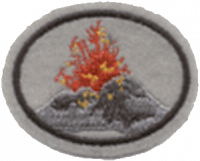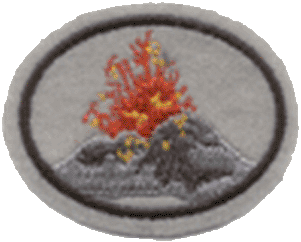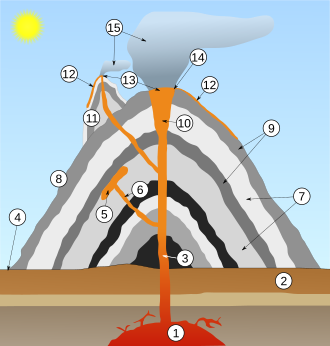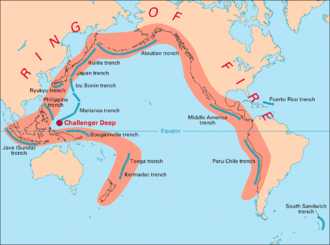Respuestas para la especialidad JA de Volcanes
1
2
2a
2b
2c
2d
2e
3
3a
3b
3c
3d
3e
3f
3g
3h
4
4a
4b
4c
4d
5
5a
i
ii
iii
iv
5b
5c
5d
5e
5f
6
- An eruption begins when pressure on a magma chamber forces magma up through the conduit and out the volcano's vents. When the magma chamber has been completely filled, the type of eruption partly depends on the amount of gases and silica in the magma. The amount of silica determines how sticky (level of viscosity) the magma is and water provides the explosive potential of steam. Obstacles also influence the type of eruption. When the pipe is blocked by a stopple or an accumulation of pumice, the pressure in the pipe will build up very high resulting in an explosion.
- When magma reaches earth's surface it is called lava. It may pour out in gentle streams called lava flows or erupt violently into the air. Rocks ripped loose from the inside of the volcano or torn apart by the gas may be shot into the air with the lava. The rocks blown out of a volcano are called pyroclastic rocks. The rock fragments fall back to earth in many different shapes and sizes.
7
- A popular way of classifying magmatic volcanoes goes by their frequency of eruption, with those that erupt regularly called active, those that have erupted in historical times but are now quiet called dormant, and those that have not erupted in historical times called extinct. However, these popular classifications—extinct in particular—are practically meaningless to scientists. They use classifications which refer to a particular volcano's formative and eruptive processes and resulting shapes, which was explained above.
7a
7b
7c
7d
8
- http://en.wikipedia.org/wiki/Pacific_ring_of_fire
- Of the more than 800 active volcanoes that have been identified, most are located along the margins of the ocean basins—most notably along the within the circum-Pacific belt known as the Ring of Fire. This active zone includes a chain of continental volcanoes that consist primarily of composite volcanoes.
- The Pacific Ring of Fire is an area of frequent earthquakes and volcanic eruptions encircling the basin of the Pacific Ocean. In a 40,000 km horseshoe shape, it is associated with a nearly continuous series of oceanic trenches, island arcs, and volcanic mountain ranges and/or plate movements. It is sometimes called the circum-Pacific belt or the circum-Pacific seismic belt. 90% of the world's earthquakes and 81% of the world's largest earthquakes occur along the Ring of Fire.
9
- The Hawaiian Islands result from the movement of the Pacific plate over an apparently stationary hot spot. The island of Hawaii is still forming from the uplifting of mantel plumes under the hot spot. The island of Hawaii is the youngest of the Hawaiian islands, and the island of Kauai is the oldest of the large islands in the Hawaiian chain.
10
- Mount St. Helens is located in southwestern Washington State, about 50 miles northeast of Portland, Oregon. It is in the Cascade Range of mountain. It was named in 1792 in honor of the Baron St. Helens. American Indians of the Pacific Northwest called it "Louwala-Clough" or "smoking mountain." The volcano was active in the mid-1800s, but most people in this century did not see it as a menace. In fact, the mountain was snow-covered and very beautiful. The forest on it and around the base was filled with wildlife. At the base of the volcano was Spirit Lake, a clear mountain lake that was very good for fishing and boating.
- In the spring of 1980, everything changed. First, there was a series of earthquakes and then came one or, maybe, two thunderous explosions. Mount St. Helens began to spew forth ash and steam. Two craters formed on the volcano and there were avalanches of snow and ice, darkened by ash. Over the next two months, the volcano continued to be active, simmering almost like a pot boiling on a stove. Then on May 18, 1980, the volcano suddenly erupted. Part of the volcano collapsed and became a huge landslide that eventually covered an area of about 24 square miles. There was also a release of pent-up pressure from within the volcano. There was a huge blast of rock, ash and hot gases that devastated an area of about 230 square miles north of the volcano. To the south, the devastated area was much less. Scientists have calculated the blast started at about 220 miles per hour but increased to about 670 miles per hour. The blast was heard as far away as Montana, Idaho, Canada and California.
- Mount St. Helens information courtesy of U.S. Geological Survey/Department of the Interior.
Other interesting Volcanoes
Other interesting volcanoes include:
- Mount Pinatubo eruption of 1991 (Philippines)
- Krakatoa eruption of 1883 (Indonesia)
- Vesuvius eruption of 79 A.D. (Italy)
- Mount Etna eruption of 1669 (Italy)
- Popocatépetl eruption of 1994 (Mexico)
- Tambora eruption of 1815 (Indonesia, most powerful eruption in recorded history)
- Taupo eruption of 181 A.D. (New Zealand, most powerful eruption in the past 5000 years).
11
(Using some imagination)
The glory of GOD—let it last forever! Let GOD enjoy his creation! He takes one look at earth and triggers an earthquake, points a finger at the mountains, and volcanoes erupt.
Part your heavens, O LORD, and come down; touch the mountains, so that they smoke.
10Remember the day you stood before the LORD your God at Horeb, when he said to me, "Assemble the people before me to hear my words so that they may learn to revere me as long as they plive in the land and may teach them to their children."
11You came near and stood at the foot of the mountain while it blazed with fire to the very heavens, with black clouds and deep darkness. 12Then the LORD spoke to you out of the fire. You heard the sound of words but saw no form; there was only a voice.
13 He declared to you his covenant, the Ten Commandments, which he commanded you to follow and then wrote them on two stone tablets.
12
There are a number of ways to approach this requirement. A very easy way to meet it is to download this PDF which is a 3D model that can be printed, cut out, and glued together.
You can also build a model volcano using the tube from a roll of paper towels or toilet paper, some newspaper, a cardboard base, and some papier-mâché.
Referencias
Adventist Youth Honors Answer Book/Regional/flpatchnote/es





